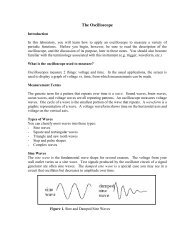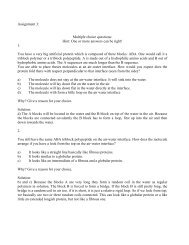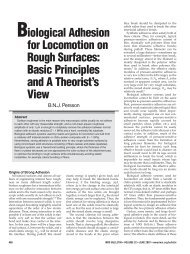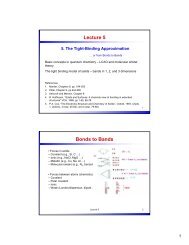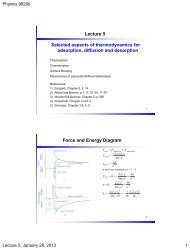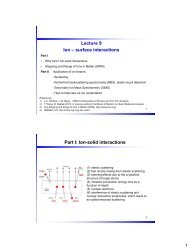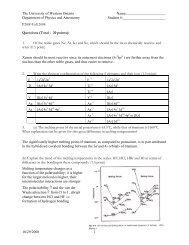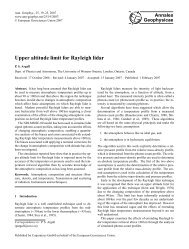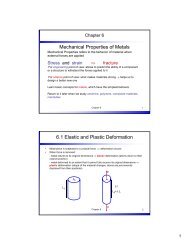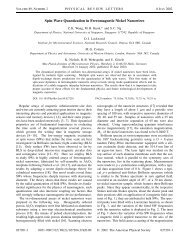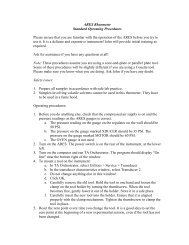Statistics of Radioactive Decay
Statistics of Radioactive Decay
Statistics of Radioactive Decay
You also want an ePaper? Increase the reach of your titles
YUMPU automatically turns print PDFs into web optimized ePapers that Google loves.
<strong>Statistics</strong> <strong>of</strong> <strong>Radioactive</strong> <strong>Decay</strong><br />
Introduction<br />
The purpose <strong>of</strong> this experiment is to analyze a set <strong>of</strong> data that contains natural variability<br />
from sample to sample, but for which the probability distribution function (i.e. the Poisson<br />
Distribution) is well known. You will compare your measurements to theoretically derived<br />
functions, and test the compatibility <strong>of</strong> your measurements and the theory. The data are<br />
obtained by measuring the decay <strong>of</strong> a radioactive source using a Geiger counter.<br />
Goals:<br />
• gain familiarity with the specific form and use <strong>of</strong> the Poisson distribution<br />
• gain experience with the use <strong>of</strong> a Geiger counter for measuring radioactive decay<br />
events<br />
Theory<br />
The disintegrations from a radioactive substance occur at random. If the number <strong>of</strong> counts is<br />
measured for a pre-specified time interval, and then the measurement is repeated over the<br />
same time interval, it is likely that that number will be different every time you perform a<br />
new measurement. It can be shown that in such cases <strong>of</strong> random decay the frequency<br />
distribution Pn () describing the probability <strong>of</strong> observing n disintegrations in some time<br />
interval t is given by the Poisson distribution. This has been discussed in your lectures. The<br />
Poisson distribution is given by<br />
Pn ()= μn e − μ<br />
n!<br />
where μ is the mean <strong>of</strong> the distribution.<br />
The standard deviation σ <strong>of</strong> this distribution is given by: σ =<br />
μ<br />
For large values <strong>of</strong> μ, the Poisson distribution approaches a Gaussian (normal) distribution:<br />
1<br />
P()=<br />
n<br />
( n− μ<br />
e− )2 2μ<br />
2πμ<br />
The Poisson Distribution – discussion<br />
In previous experiments, we discussed random experimental errors which resulted from<br />
limitations <strong>of</strong> the experiment itself due to imperfections <strong>of</strong> apparatus or technique. There is<br />
another class <strong>of</strong> error which is due to the random nature <strong>of</strong> the process being studied, and this<br />
second category is the subject <strong>of</strong> our current experiment. This is <strong>of</strong>ten associated with
“counting” experiments (an important category in modern day physics) and follows the rules<br />
<strong>of</strong> Poisson <strong>Statistics</strong>.<br />
Consider an experiment to measure radioactive decay. One could count the number <strong>of</strong><br />
decays in a series <strong>of</strong> (say) 10-s intervals. Since radioactive decays are random in time, the<br />
number <strong>of</strong> decays will not be repeatable between successive measurements. There will be a<br />
mean value, but rarely will any measurement actually produce this value. For example,<br />
suppose the true mean was 9 counts. Then due to the intrinsic natural variability, it may be<br />
possible to measure as low as only 1 or 2 counts, or perhaps as high as 20 counts, using the<br />
same experimental setup, because <strong>of</strong> the random nature <strong>of</strong> the process. The Poisson<br />
distribution gives you the probability Pn ( ) that you will obtain n counts when the mean<br />
count over many measurements is μ.<br />
Notice that n is an integer in this distribution (i.e. you either count something or you don’t).<br />
Also, this distribution is very non-symmetric (skewed) when μ is small. This is very<br />
different to the distributions that you have normally met so far, for which you assumed you<br />
could have a + or – error with equal probability. Part <strong>of</strong> the reason that the distribution is<br />
skewed is that you can’t have a negative number <strong>of</strong> counts. However, when μ is large (say ><br />
30) the Poisson distribution approaches a Gaussian distribution with a mean μ and a standard<br />
deviation μ .<br />
If you are doing a counting experiment in the laboratory (e.g. scattering, γ -ray spectroscopy,<br />
or α-particle absorption), you can say that the best estimate <strong>of</strong> the mean number <strong>of</strong> counts is<br />
the measured mean value n , and the best estimate <strong>of</strong> the standard deviation about this mean<br />
is n . The point here is that you can never know the true mean μ because that would<br />
require an infinite number <strong>of</strong> measurements.<br />
The Geiger-Muller (GM) Counter<br />
The GM counter is a combination <strong>of</strong> two devices:<br />
- a GM tube for the detection <strong>of</strong> radioactivity<br />
- an instrument that amplifies and counts the electrical signals received from the GM tube<br />
The tube has a very thin glass window facing the radioactive source. This permits the<br />
electrons emitted from the source to pass into the interior with minor absorption and<br />
scattering. The GM tube consists <strong>of</strong> an outer cylindrical conductor and a central wire<br />
maintained at a positive potential with respect to the outer cylinder. As an energetic particle<br />
crosses the detector it will ionize a gas molecule in the chamber. The resulting electron and<br />
ion are accelerated by the potential, each towards the electrode with opposite sign. For large<br />
enough potential difference the electron released in the ionization process will ionize another<br />
2
molecule and this will result in an avalanche <strong>of</strong> charges that could be detected as an electrical<br />
signal. The range <strong>of</strong> voltages applied to the GM tube that will generate a signal for an<br />
incoming ionizing particle is called the Geiger-Muller region. In other words the sensitivity<br />
<strong>of</strong> the amplifier connected to the tube is such that counts are only detected when the tube is<br />
operating in the Geiger-Muller region. Different tubes have different characteristics. In our<br />
experiment we will use a tube with a range <strong>of</strong> 300-1000V.<br />
The radioactive source used in this experiment is Thallium 204, a radioactive isotope with a<br />
half-life <strong>of</strong> 3.8 years. When it disintegrates, an electron with energy <strong>of</strong> 0.77 MeV is emitted.<br />
It thus has sufficient energy to penetrate the tube and produce a count.<br />
Experiment:<br />
Apparatus:<br />
• Geiger-Muller tube, stand and shelf<br />
• High voltage source and counter<br />
• Tl 204 source<br />
• timer<br />
Procedure<br />
Part I<br />
Among your equipment you will find two semicircular pieces <strong>of</strong> plastic. One is unmarked;<br />
this is the non- radioactive blank. The other is the radioactive source. Record the number and<br />
letter on the source in your lab book.<br />
Check that the high voltage controls are set at minimum values, and switch the power on.<br />
The “test” switch should be <strong>of</strong>f, and the “count” switch should be on. Switch on the preset<br />
timer, and set it to 10 seconds. Put the source and the blank together on the tray and put it on<br />
shelf number 4.<br />
Increase the voltage to 500 V. Start the timer and record the number <strong>of</strong> counts in 10 seconds.<br />
If necessary move the source to another shelf and repeat until the number <strong>of</strong> counts is<br />
between 800 and 4000. If you still cannot achieve a value <strong>of</strong> at least 800, record for a little<br />
longer, e.g. 15 or 20 or even 30 seconds.<br />
Measure the number <strong>of</strong> counts in your chosen time interval. Repeat 45 times.<br />
3
Part 2<br />
Set the source far from the detector so that the number <strong>of</strong> counts obtained in 10 seconds is<br />
small. This will represent your “background level”, and is due to natural radioactivity around<br />
you – in the walls, due to cosmic ray particles etc. Typically you should get values <strong>of</strong> the<br />
order <strong>of</strong> 1, 2, 3, 4, with less frequent occurrences <strong>of</strong> numbers like 5, 6, 7 etc. If you find you<br />
are getting lots <strong>of</strong> 5’s and 6’s, say, reduce the recording time to say 5 seconds. If you are<br />
getting mainly 0’s and 1’s, increase your recording time. Measure the number <strong>of</strong> counts in<br />
your selected recording period. Repeat 45 times. Note that the recording interval you choose<br />
does not have to be the same as in Part I.<br />
Analysis<br />
Analyze the “background counts” first, then the “source” results, as follows.<br />
a) Background counts.<br />
1) Plot the data in a histogram format (i.e. abscissa = number <strong>of</strong> counts, ordinate = number<br />
<strong>of</strong> measurements yielding that number <strong>of</strong> counts). Use a bin size <strong>of</strong> one count. You are<br />
encouraged to do this with a spread-sheet (like Excel) if possible.<br />
2) Determine the mean, n , and then plot the expected Poisson distribution for this mean<br />
value over top <strong>of</strong> your own data. Ensure that the area under your experimental curve and<br />
your theoretical curve are the same (remember that the formula given earlier for the<br />
Poisson distribution was normalized to unit area). Also check the standard deviation, and<br />
check if it is similar to n . (Note: this might be a good chance for you to learn how to<br />
use the “standard deviation” option on your calculator, or you might use the same<br />
function in your spread-sheet package. (It is STDEV in Excel)<br />
3) You will have recorded 45 successive counts e.g. 2, 3, 2, 1, 4, 3, .. etc. Sum the points in<br />
groups <strong>of</strong> 3. In the above example, your first point will be 2+3+2 = 7, and the next point<br />
will be 1+4+3 = 8, etc. This will simulate using a longer averaging interval – e.g. if you<br />
used 10 second intervals, summing 3 successive values will give you an equivalent rate<br />
for a 30-second interval. You will now only have 15 points. Calculate your new mean<br />
and standard deviation. Check again whether the standard deviation is similar to n<br />
(rigorous comparison is not necessary – a qualitative comparison will do for now). Plot<br />
the expected Poisson distribution, using your new mean. Comment on the symmetry <strong>of</strong><br />
your graph relative to the first one. Also plot the theoretical distribution assuming it is a<br />
Gaussian.<br />
4
) <strong>Radioactive</strong> Source counts.<br />
The case where you deal with the radioactive source can be considered as an extension <strong>of</strong> the<br />
“background case” to the situation <strong>of</strong> much higher count rates. What do you expect the<br />
distribution to start to look like at high count rates<br />
1. Plot the data in a histogram format (i.e. abscissa = number <strong>of</strong> counts, ordinate = number<br />
<strong>of</strong> measurements yielding that number <strong>of</strong> counts). Note that this time you will need to<br />
experiment with the best choice <strong>of</strong> bin-size. Describe why you use the choice <strong>of</strong> bin-size<br />
that you do. (Again, you might also find it useful to use a spreadsheet).<br />
2. Determine the mean, and the standard deviation, and check that the relation σ = n still<br />
seems valid. Then plot the expected theoretical distribution (for this mean value and<br />
standard deviation) over top <strong>of</strong> your own data. (Should this be a Poisson distribution, or a<br />
Gaussian, or are they equivalent Discuss). Ensure that the area under your experimental<br />
curve and your theoretical curve are the same.<br />
3. From your histogram, estimate the probability <strong>of</strong> getting a single number <strong>of</strong> counts n<br />
which lies between n and n + 50 . Now repeat the same determination, but this time<br />
using your theoretical fitted curve. In this case you may assume that your standard<br />
deviation squared is an exact estimate <strong>of</strong> the true variance, so you may treat your<br />
distribution as a normal distribution with known variance. Remember you are looking at<br />
the likelihood <strong>of</strong> obtaining a single value in this range. Will you use the standard<br />
deviation σ, orσ 45 , in your calculations You may use your “normal-distribution”<br />
table in your lecture notes if you like.<br />
4. Divide the data into three groups (a,b,c) <strong>of</strong> 15 measurements, and find the mean and its<br />
standard deviation for the three sets. For example, for set a<br />
15<br />
15<br />
⎛ ⎞<br />
n a<br />
= ∑n i<br />
⎝<br />
⎜<br />
i=1 ⎠<br />
⎟ 15 andσ na<br />
= ∑( n i<br />
− n a ) 2<br />
( 15 − 1)15<br />
().<br />
i=1<br />
Test the hypothesis that these 3 data sets are statistically equivalent by determining<br />
whether the 3 means are really the same number, statistically speaking. Do this by<br />
computing the mean <strong>of</strong> the 3 means, n all<br />
, and the corresponding χ 2 :<br />
( ) 2<br />
χ 2 = n − n a all<br />
+ n − n b all<br />
+ n − n c all<br />
2 2<br />
σ na<br />
( ) 2<br />
σ nb<br />
( ) 2<br />
σ nc<br />
2<br />
.<br />
From the χ 2 distribution, the most likely value <strong>of</strong> χ 2 is 2. Why<br />
If you have access to Excel (use CHIDIST) or MATLAB (or equivalent), you can get the<br />
probability that your value <strong>of</strong> χ 2 > 2 . If this probability is not too small, say greater than<br />
10%, then you have shown that the hypothesis is true (statistically speaking <strong>of</strong> course!).<br />
5



